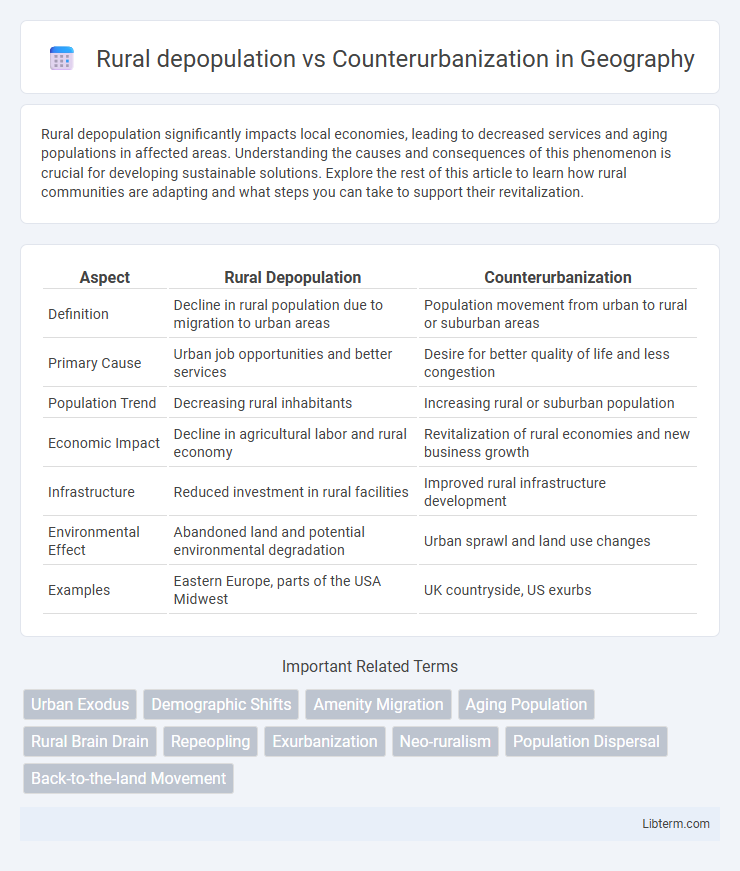Rural depopulation significantly impacts local economies, leading to decreased services and aging populations in affected areas. Understanding the causes and consequences of this phenomenon is crucial for developing sustainable solutions. Explore the rest of this article to learn how rural communities are adapting and what steps you can take to support their revitalization.
Table of Comparison
| Aspect | Rural Depopulation | Counterurbanization |
|---|---|---|
| Definition | Decline in rural population due to migration to urban areas | Population movement from urban to rural or suburban areas |
| Primary Cause | Urban job opportunities and better services | Desire for better quality of life and less congestion |
| Population Trend | Decreasing rural inhabitants | Increasing rural or suburban population |
| Economic Impact | Decline in agricultural labor and rural economy | Revitalization of rural economies and new business growth |
| Infrastructure | Reduced investment in rural facilities | Improved rural infrastructure development |
| Environmental Effect | Abandoned land and potential environmental degradation | Urban sprawl and land use changes |
| Examples | Eastern Europe, parts of the USA Midwest | UK countryside, US exurbs |
Understanding Rural Depopulation
Rural depopulation refers to the significant decline in population within countryside areas, driven by factors such as limited employment opportunities, aging demographics, and migration to urban centers for better services. This process results in economic challenges, reduced public services, and social isolation for remaining residents. Understanding rural depopulation is essential for developing policies that address infrastructure deficits and promote sustainable rural development.
Defining Counterurbanization
Counterurbanization refers to the demographic and social process where people migrate from urban areas to rural or less densely populated regions, reversing previous urban growth trends. This phenomenon often arises due to factors like improved transportation, telecommuting capabilities, and a desire for a higher quality of life away from city congestion. Unlike rural depopulation, which denotes population decline in rural areas, counterurbanization leads to population stabilization or growth in these regions by attracting urban dwellers.
Historical Trends in Rural Population Shifts
Historical trends in rural population shifts reveal a sustained period of rural depopulation during the Industrial Revolution as agricultural mechanization reduced labor needs, prompting migration to urban centers. From the mid-20th century, counterurbanization emerged, with some rural areas experiencing population growth due to improved transportation, telecommunication technologies, and lifestyle preferences favoring less congested environments. Data from developed countries like the United States and the United Kingdom indicate that while early 20th-century rural areas declined sharply, late 20th and early 21st centuries saw selective repopulation of rural communities, driven by urban-to-rural migration patterns.
Causes of Rural Depopulation
Rural depopulation primarily results from limited economic opportunities, declining agricultural viability, and inadequate access to education and healthcare services, driving residents to urban centers in search of better livelihoods. Factors such as mechanization of farming reduce labor demand, while younger populations migrate for employment and social amenities, accelerating population loss in rural areas. Environmental challenges, including land degradation and climate change impacts, further exacerbate outmigration trends contributing to rural decline.
Drivers of Counterurbanization
Counterurbanization is driven by factors such as improved transportation infrastructure, digital connectivity enabling remote work, and the rising cost of urban living that pushes individuals and families toward rural areas. Enhanced quality of life preferences, including access to natural environments, lower crime rates, and less pollution, also contribute significantly. Demographic shifts such as retirees seeking tranquility and young professionals desiring affordable housing further accelerate counterurbanization trends.
Socioeconomic Impacts on Rural Communities
Rural depopulation leads to labor shortages, reduced economic activity, and declining public services in affected communities, exacerbating poverty and social isolation. Counterurbanization brings new residents with diverse skills and increased demand for local goods and services, stimulating economic growth and revitalizing infrastructure. Both phenomena reshape rural social structures, influencing education, healthcare access, and demographic composition in distinct ways.
Urban to Rural Migration Patterns
Urban to rural migration patterns reveal a growing trend where individuals and families move away from densely populated cities to less crowded rural areas, driven by factors such as affordable housing, improved remote work technologies, and desire for better quality of life. Rural depopulation occurs when outmigration exceeds in-migration, leading to declines in local economies and aging populations, especially in regions lacking employment opportunities. Counterurbanization reverses this trend by attracting urban dwellers to rural communities, often revitalizing local economies through new investments and demographic diversification.
Policy Responses and Initiatives
Policy responses to rural depopulation emphasize investments in infrastructure, healthcare, and education to enhance living standards and economic opportunities in declining regions. Counterurbanization initiatives often include incentives for remote work, support for small businesses, and promotion of sustainable tourism to attract and retain residents. Effective strategies integrate technology access and community development programs to balance demographic shifts and stimulate local economies.
Case Studies: Global Perspectives
Rural depopulation, characterized by declining population densities and economic opportunities, is evident in regions such as Japan's mountainous villages and parts of Eastern Europe like Romania's rural counties experiencing significant youth outmigration. In contrast, counterurbanization trends are prominent in countries like Australia and the United States, where urban residents relocate to smaller towns and rural areas, driven by lifestyle preferences and remote work capabilities. Comparative case studies reveal that policy responses and infrastructure development greatly influence the success of counterurbanization as a strategy to revitalize rural communities globally.
Future Outlook and Sustainable Solutions
Rural depopulation is expected to continue in many regions due to limited economic opportunities and aging populations, while counterurbanization gains traction as remote work and lifestyle preferences shift. Sustainable solutions include investing in digital infrastructure, promoting local entrepreneurship, and enhancing access to healthcare and education to attract and retain residents. Future outlooks emphasize integrating green technologies and community-based planning to balance development with environmental preservation in rural areas.
Rural depopulation Infographic

 libterm.com
libterm.com